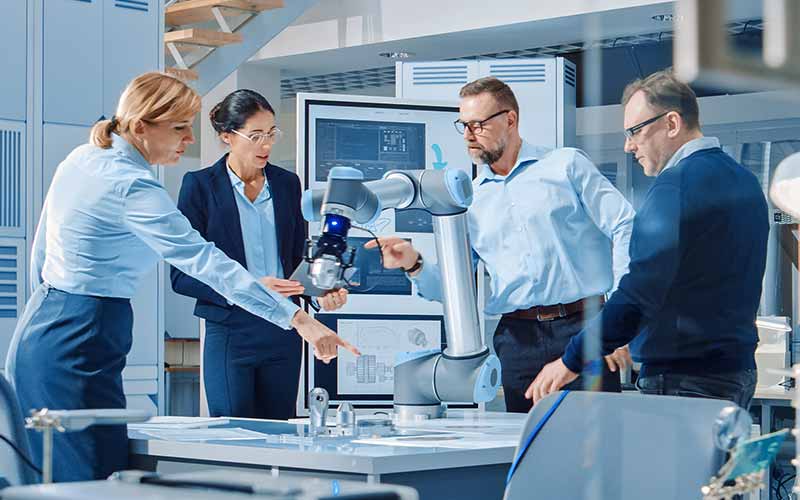In the realm of national security and technological prowess, Defence and Aerospace Manufacturing stands as a cornerstone. This multifaceted industry encompasses the design, development, and production of aerospace and defense systems vital for safeguarding nations and exploring the cosmos. From cutting-edge fighter jets to advanced satellite systems, the domain of Defence and Aerospace Manufacturing is as dynamic as it is critical.

Understanding Defence and Aerospace Manufacturing
Defining Defence and Aerospace Manufacturing:
At its core, Defence and Aerospace Manufacturing involves the creation of military and civilian aerospace technologies. This includes aircraft, spacecraft, missiles, and associated components, ranging from propulsion systems to avionics.
The Significance of Defence Manufacturing:
Defence manufacturing plays a pivotal role in ensuring national security and sovereignty. It provides nations with the capability to defend against threats, both domestic and foreign, while also fostering technological innovation and economic growth.
Aerospace Manufacturing:
On the civilian front, aerospace manufacturing drives advancements in air travel, satellite communications, and space exploration. It enables the exploration of new frontiers and facilitates global connectivity through satellite networks and GPS systems.
Innovations in Defence and Aerospace
Technological Advancements:
Advancements in Defence and Aerospace Manufacturing continue to redefine the industry landscape. From stealth technology to unmanned aerial vehicles (UAVs), innovation drives progress, enhancing capabilities and ensuring strategic superiority.
Additive Manufacturing (3D Printing):
One notable innovation revolutionizing the industry is additive manufacturing, commonly known as 3D printing. This technology allows for the rapid prototyping and production of complex aerospace components, reducing costs and lead times while enabling customization and optimization.
Green Initiatives:
In recent years, there has been a concerted effort to integrate sustainable practices into Defence and Aerospace Manufacturing. Initiatives such as eco-friendly propulsion systems and lightweight materials contribute to reducing environmental impact while maintaining operational effectiveness.
Challenges and Opportunities
Supply Chain Resilience:
One of the primary challenges facing Defence and Aerospace Manufacturing is ensuring supply chain resilience. The industry relies on a complex network of suppliers and subcontractors, making it vulnerable to disruptions caused by geopolitical tensions, natural disasters, or pandemics.
Workforce Skills Gap:
Another challenge lies in addressing the skills gap within the workforce. As technology evolves, there is a growing need for highly skilled professionals proficient in areas such as engineering, data analytics, and cybersecurity.
Global Collaboration:
Despite these challenges, there are ample opportunities for global collaboration and partnership within the Defence and Aerospace Manufacturing sector. International cooperation not only fosters innovation but also strengthens diplomatic ties and promotes peace and stability.
FAQs (Frequently Asked Questions)
Question: How does Defence and Aerospace Manufacturing contribute to national security?
Answer: Defence and Aerospace Manufacturing provides nations with the necessary capabilities to defend against threats and maintain strategic superiority, ensuring the safety and sovereignty of citizens.
Question: What role does innovation play in the industry?
Answer: Innovation drives progress in Defence and Aerospace Manufacturing, leading to advancements in technology, performance, and efficiency. It enables the development of cutting-edge systems and ensures that nations remain at the forefront of defense and aerospace capabilities.
Question: How does additive manufacturing benefit Defence and Aerospace Manufacturing?
Answer: Additive manufacturing, or 3D printing, offers numerous benefits to the industry, including rapid prototyping, cost savings, and design flexibility. It allows for the production of complex components with reduced lead times and enables on-demand manufacturing of spare parts.
Question: What are some emerging trends in Defence and Aerospace Manufacturing?
Answer: Emerging trends in the industry include the adoption of artificial intelligence, autonomous systems, and electrification. These technologies promise to revolutionize operations, enhance mission capabilities, and improve sustainability.
Question: How does Defence and Aerospace Manufacturing contribute to economic growth?
Answer: Defence and Aerospace Manufacturing stimulates economic growth through job creation, innovation, and technological spin-offs. It fosters a robust industrial base and generates revenue through exports and international partnerships.
Question: What measures are being taken to address environmental concerns in the industry?
Answer: The industry is increasingly adopting sustainable practices, such as the use of biofuels, energy-efficient propulsion systems, and recyclable materials. These initiatives aim to minimize environmental impact and promote long-term sustainability.
Conclusion
In conclusion, Defence and Aerospace Manufacturing is a cornerstone of national security and technological advancement. From safeguarding borders to exploring the cosmos, this dynamic industry shapes the future of defense and aerospace capabilities. By embracing innovation, addressing challenges, and fostering collaboration, nations can ensure a safer, more prosperous future for generations to come.
Comments on “Exploring Defence and Aerospace Manufacturing”